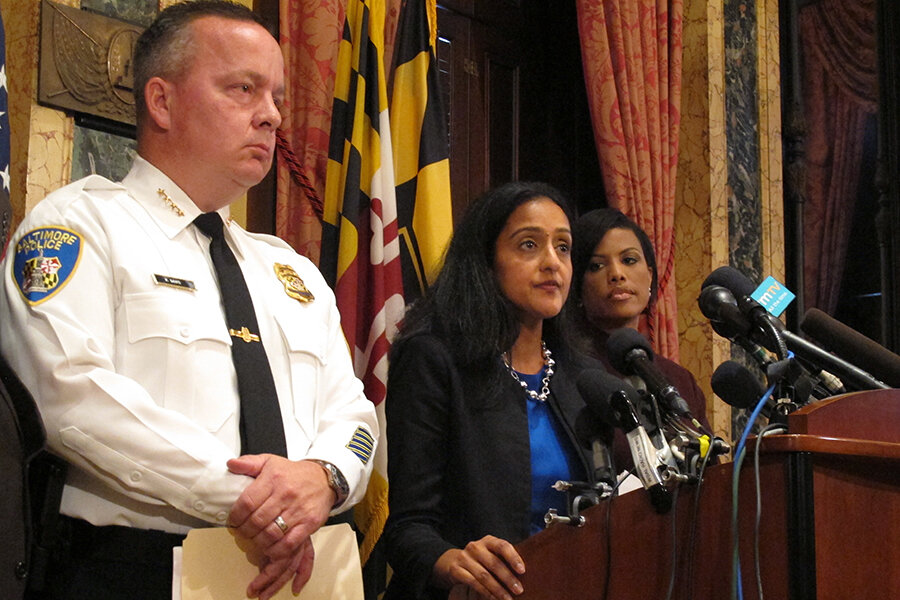'Breathing while black'? Baltimore police report uncovers gross injustice
Loading...
| Atlanta
In one district of the Baltimore Police Department, a template for a trespassing summons already had one line filled in that predicted who would receive the ticket: black male.
In 2011, a shift commander issued an order to “lock up all the black hoodies.”
Of people stopped by Baltimore police between January 2010 and June 2015, 84 percent were African-Americans even though they only make up 63 percent of the city's population.
Never mind “driving while black,” a scathing US Department of Justice (DOJ) report released on Tuesday found that African-Americans in Baltimore for years have been in a state of assumed guilt for “breathing while black,” as City Councilman Brandon Scott summed it up. The report lists dozens of widespread constitutional violations as officers used illegal “short-term crime suppression” techniques that allowed police to even “criminaliz[e] the act of standing on public sidewalks.”
Such actions don’t just hurt minorities; they engender deep distrust of cops in some neighborhoods. This, tragically, “makes policing unsafe for police officers,” says former Seattle police chief Norm Stamper, author of “To Protect and Serve: How to Fix America’s Police.”
Baltimore now joins over a dozen other American cities – including Albuquerque, N.M.; Cleveland; Ferguson, Mo.; and Seattle – that face federal pressure in the form of court orders or joint agreements with the DOJ to stop racially discriminating against citizens. The report, police accountability experts say, is also part of a broader federal push to shift the focus from individual instances of potential police misconduct to examine how and why police departments allow repeated violations of minority citizens’ constitutional rights.
“The problem with focusing on individual citizen complaints is it makes the officers the fall guy, where the whole DOJ effort is designed to change the organization, because that’s where the fault lies,” says Samuel Walker, a criminologist at the University of Nebraska at Omaha and a noted expert on police accountability.
Sparks of reform?
Such investigations could spark widespread reforms in other cities.
“The fact that DOJ is making determinations that certain enforcement initiatives in Baltimore may have contributed to particular [discriminatory] trends, it’s going to cause every police chief and commissioner to read it and say: ‘Do we have similar problems here? Do I need to address this with my folks?’ ” says Matthew Barge, co-executive director of the Police Assessment Resource Center in New York City. “And that’s how [new training and new procedures] can spread and very rapidly get adopted by more and more cities, leading to real changes in the ways that police approach the business of policing.”
Many complain that the federal government is not doing enough to root out racism in police departments, with some calling for federal certification for local police officers to make sure they’re properly vetted and trained.
The problems in Baltimore became increasingly apparent in the 1990s, in the midst of a crack-fueled crime wave. The police push, critics say, was to harass potential troublemakers into submission. But the backlash began almost immediately, as residents began complaining about tactics that seemed to target primarily poor black people.
As tensions built, the city curbed so-called zero-tolerance policing in 2006, and arrest rates began to decrease. But institutionally, the policy – which was in place when many supervisors were rookies – largely remained.
Cops were told to “clear corners,” even if it meant “making something up,” and the focus was put on arrest rates instead of problem-solving issues in neighborhoods. Two small African-American neighborhoods, which comprise 11 percent of the city’s population, saw 44 percent of the city’s total pedestrian stops.
From November 2010 to July 2015, African Americans in Baltimore were charged at a rate of one offense per 1.4 residents; everyone else was charged with one offense for every 5.1 residents.
That corrosive lack of trust fed rallies and riots last year after a 25-year-old named Freddie Gray died from injuries sustained while in police custody. Six officers were charged. Three were acquitted, one jury could not reach a decision, and charges were dropped against that officer and the two others. At the behest of local and congressional leaders, the Justice Department, under a 1994 law, began an in-depth probe of the city’s policing practices.
A matter of rights
Selective enforcement may have yielded results, but some or perhaps much of it has been at heart fundamentally illegal, the DOJ surmised, as officers, prompted by their superiors, disregarded very specific constitutional protections in order to control the streets.
“There are too many cops who believe that they are literally above the law,” Mr. Stamper says. “They know what the Constitution says. They know what police can and cannot do. But their own culture is the product of a very rigid, paramilitary and bureaucratic arrangement, and it should not be difficult for anyone to understand how the code of violence is nurtured under that system. It’s very real, and it’s very much alive in virtually every city in the country.”
The DOJ report also explained how many officers chafe at quota systems and other strategies that use arrest statistics to reward officers, creating at times perverse motives to ignore people’s constitutional rights, which in turn can escalate situations to violence. In Baltimore, the report found, “providing policing … is particularly challenging, where officers regularly confront complex social problems rooted in poverty, racial segregation” and housing and job disparities.
In Baltimore, efforts are already under way to rewrite use of force and pursuit policies. Similar probes in other cities have yielded measurable improvements and greater collaboration between police and their community critics, says Stamper.
One potential reason for that progress is that it appears many US police officers, too, are disillusioned. The DOJ report’s authors wrote that they were “grateful for [the officers’] candor in discussing the serious challenges they face and their genuine interest” in reform.






